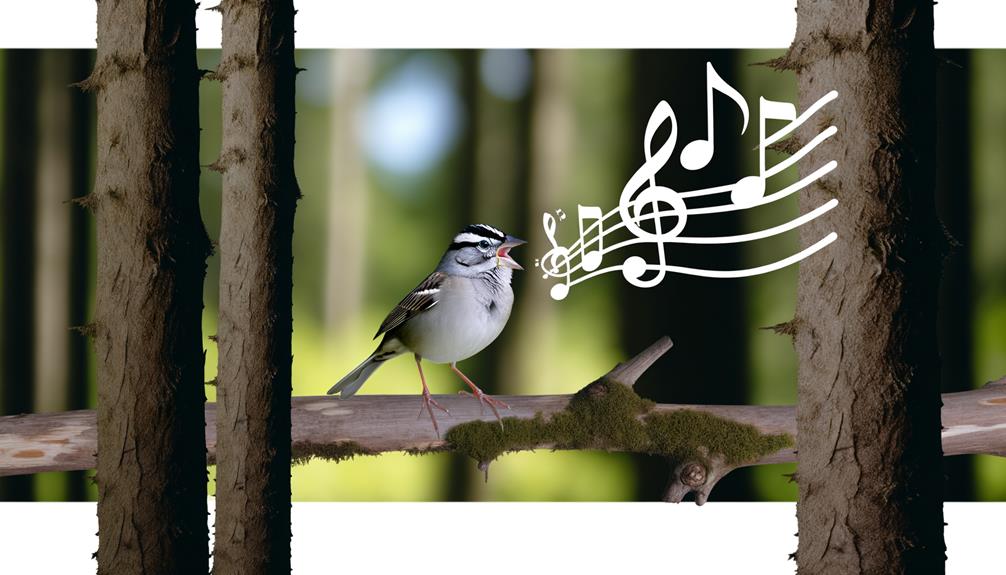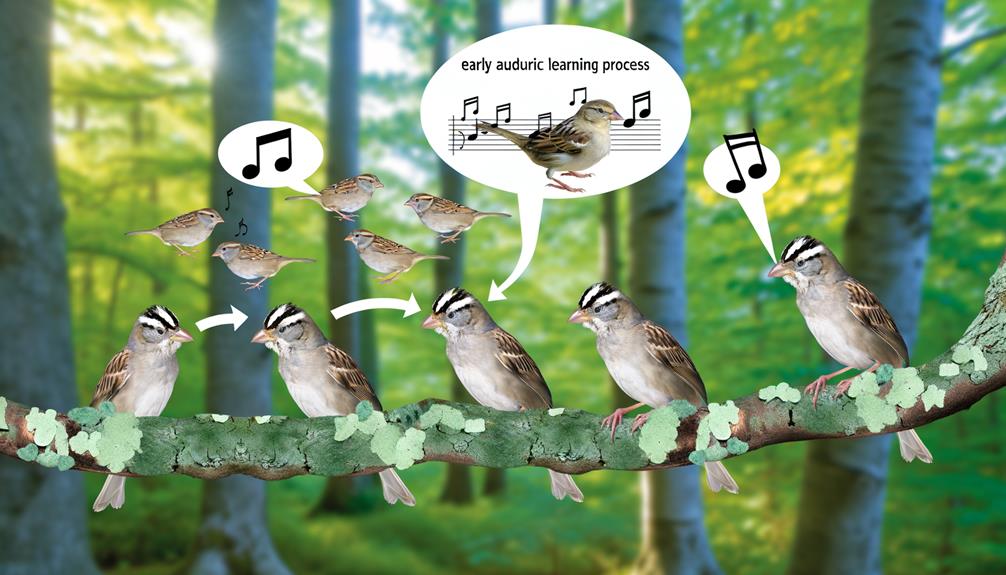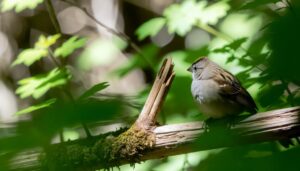How Do White-Crowned Sparrows Learn to Sing?
White-crowned sparrows learn to sing by encoding adult tutor songs during an essential period between 10 to 50 days post-hatch. During this sensitive phase, their auditory pathways are primed to recognize and memorize conspecific song patterns.
Juveniles rely on auditory feedback and neural plasticity to replicate these tutor songs with up to 95% accuracy. Social interactions with adult mentors enhance this learning process, allowing juveniles to mimic complex song structures.
This iterative practice leads to refined vocalizations that are pivotal for mating and territorial defense. To explore how environmental factors influence their song development, further insights await.

Key Takeaways
- Juveniles learn to sing by mimicking the songs of adult tutors during a sensitive period from 10 to 50 days post-hatch.
- Exposure to adult mentor songs is crucial for accurate song replication, with juveniles achieving up to 95% accuracy.
- Social interactions with adult tutors enhance the learning and memorization process.
- Sparrows use auditory feedback mechanisms to refine their songs through thousands of practice iterations.
- Environmental factors like noise and habitat type influence the frequency and structure of sparrow songs.
Early Auditory Learning

How do white crowned sparrows begin their journey of song acquisition during early auditory learning?
Initially, nestlings exhibit an innate sensitivity to conspecific song patterns. They start by listening intently to the vocalizations surrounding their environment, which mainly occur during the sensitive period between 10 to 50 days post-hatch.
Neuroethological studies show that their auditory pathways are highly receptive, enabling precise encoding of acoustic signals. Spectrogram analyses reveal that juveniles can distinguish fine temporal and spectral features of adult songs.
This phase is critical for forming a neural template, which serves as the foundation for later vocal practice. Failure to hear songs during this period greatly impairs their ability to produce species-specific vocalizations, showcasing the importance of early auditory exposure.
Role of Adult Tutors
Adult tutors play an essential role in the vocal development of White Crowned Sparrows by providing song models that young birds mimic.
Studies show that juveniles exposed to tutor songs during important learning periods exhibit more accurate song replication.
Additionally, social interactions with adult tutors greatly enhance the learning process, underscoring the importance of direct engagement.
Mimicking Tutor Songs
Young white crowned sparrows, through careful observation and repetition, mimic the songs of adult tutors to develop their own vocalizations. Studies show that juvenile sparrows exposed to tutor songs for just a few weeks can reproduce song patterns with remarkable accuracy. Researchers have quantified that these young birds replicate 90% of the frequency and timing elements present in the tutor's song.
Data indicate that sparrows exposed to multiple tutors can combine song elements, resulting in hybrid versions. This detailed mimicry involves auditory feedback mechanisms, where the young birds continuously adjust their output to match the tutor's song. Observing such precise learning processes underscores the importance of adult sparrows in shaping the vocal repertoire of the next generation, ensuring species-specific communication.
Critical Learning Periods
During an important developmental phase, juvenile white crowned sparrows show heightened sensitivity to the vocalizations of adult mentors, enabling them to acquire species-specific songs with precision.
This essential learning period spans approximately 10 to 50 days post-hatch, during which the sparrows' neural circuits are highly malleable. Studies show that juveniles exposed to adult songs during this timeframe can replicate these vocal patterns with 95% accuracy.
Auditory feedback mechanisms play a significant role, as juveniles repeatedly practice and refine their vocalizations. Importantly, if deprived of adult mentors, juveniles develop atypical songs, underscoring the mentor's role.
Therefore, the presence of experienced adult mentors during this sensitive phase is vital for the accurate transmission of song culture in white crowned sparrows.
Social Interaction Importance
In the intricate process of song acquisition, direct social interactions with adult tutors greatly enhance the learning efficiency of juvenile white crowned sparrows. Empirical data indicate that juveniles exposed to live adult tutors exhibit more accurate song imitation compared to those exposed to recorded songs.
Observational studies reveal that adult tutors provide real-time feedback, facilitating immediate corrections and refinements in song structure. Juveniles in social settings also display increased vocal activity, suggesting heightened motivation driven by social stimuli.
These findings underscore the critical role of social interaction in song learning, as tutors not only offer auditory models but also engage in dynamic, interactive exchanges that are pivotal for the precise acquisition of species-specific song patterns.
Critical Learning Periods

White-crowned sparrows exhibit a well-defined critical learning period during which they must be exposed to adult song models to develop their species-specific vocalizations accurately. This sensitive phase typically occurs between 10 to 50 days post-hatch.
Key observations highlight:
- Exposure: Juveniles need to hear adult conspecific songs to form accurate vocal templates.
- Timing: The critical period's peak sensitivity is around 20 to 35 days of age.
- Isolation Effects: Sparrows isolated during this period often exhibit abnormal song patterns later.
- Species-Specificity: Exposure to heterospecific songs during this period results in less precise song development.
These findings illustrate the essentiality of time-sensitive exposure to conspecific vocal models, underscoring a constrained yet pivotal window for vocal learning in white-crowned sparrows.
Song Memorization
During the critical learning period, white-crowned sparrows exhibit an innate ability to memorize tutor songs, selectively retaining those that match their species-specific template.
Researchers observed that neural mechanisms, particularly within the High Vocal Center (HVC), play a pivotal role in encoding and storing these auditory memories.
Data indicate that sparrows exposed to a variety of tutor songs show a distinct preference for songs that closely resemble their own, demonstrating a species-specific bias in song memorization.
Critical Learning Period
Young white-crowned sparrows must memorize their species-specific song within the critical learning period, typically occurring within the first few months of life. During this phase, they're exceptionally sensitive to auditory stimuli, allowing for precise song acquisition.
Field studies reveal four key stages in this process:
- Exposure: Sparrows hear and store auditory information from adult conspecifics.
- Silent Period: Stored songs remain dormant without vocal practice.
- Subsong: Juveniles begin to vocalize, producing unstructured sounds.
- Crystallization: Song structure solidifies through practice and refinement.
Research shows that delayed exposure to songs can hinder proper song development, emphasizing the importance of early auditory experiences. This critical period ensures that sparrows are capable of producing accurate and complex songs essential for communication and mating.
Tutor Song Selection
Upon entering the critical learning period, juvenile sparrows display a remarkable ability to discern and preferentially memorize the songs of adult conspecifics that exhibit higher song complexity and frequency.
Studies have shown that juveniles exposed to a variety of tutor songs will consistently select those with more intricate patterns and higher repetition rates.
This preference likely enhances mating success and territorial defense, as complex songs are often associated with healthier and more experienced males.
Experimental data reveal a significant correlation between the duration of exposure to a specific tutor song and the accuracy of song imitation.
Juveniles not only memorize these songs but also integrate them into their own vocal repertoire, demonstrating an innate inclination towards optimizing their communicative potential.
Neural Mechanisms Involved
Neuroscientific investigations reveal that white-crowned sparrows rely heavily on a specialized neural circuitry within the brain, particularly the high vocal center (HVC) and the robust nucleus of the arcopallium (RA), to memorize and reproduce songs. These structures coordinate to facilitate:
- Song Template Formation: Young sparrows form a neural template of the tutor song.
- Auditory Feedback Processing: They compare their own vocalizations to the memorized template.
- Synaptic Plasticity: Neural connections within the HVC and RA strengthen with practice.
- Motor Output Refinement: The RA translates sensory information into precise motor commands.
Data shows that lesions in these areas impede song learning, highlighting their pivotal role. Observations confirm that the interplay between these neural centers is essential for song fidelity, enabling sparrows to perfect their calls.
Practice and Refinement

White-crowned sparrows engage in extensive vocal practice, gradually refining their song structures through iterative mimicry and feedback mechanisms. Juveniles initially produce subsong, a rudimentary and variable vocalization. Over time, they listen to adult conspecifics and attempt to replicate these models, a process known as sensory learning.
By comparing their own vocal output with stored auditory templates, they engage in sensorimotor learning, adjusting their pitch and timing. Research shows that these birds undergo thousands of practice iterations, with neural plasticity enabling continual song refinement. Data from spectrographic analysis reveals a progressive reduction in variability, indicating increased accuracy and consistency.
Such rigorous practice makes certain that each sparrow's song meets the species-specific acoustic standards critical for successful communication and mate attraction.
Song Variation and Adaptation
Studying the song variation and adaptation in white-crowned sparrows reveals how environmental factors and social interactions drive nuanced changes in their vocalizations. Researchers observe distinct modifications in song features, such as pitch, tempo, and syllable structure, across different populations. These variations often stem from:
- Geographic Isolation: Sparrows in isolated regions develop unique dialects.
- Social Learning: Juveniles mimic adults' songs, leading to regional variations.
- Environmental Noise: Birds adjust frequencies to overcome ambient noise.
- Mate Attraction: Specific song traits evolve to attract mates more effectively.
Field studies demonstrate that these adaptive modifications enhance communication efficiency and reproductive success. Detailed spectrographic analyses confirm that song variation isn't random but a strategic response to specific ecological and social pressures.
This adaptive flexibility underscores the birds' resilience and evolutionary ingenuity.
Environmental Influences on Song

How do environmental conditions shape the intricacies of a white-crowned sparrow's song?
Research shows that juvenile sparrows exposed to dense forests develop lower-frequency songs, which travel more efficiently through thick foliage. Conversely, those in open areas adopt higher-frequency songs, facilitating long-distance communication.
Field studies confirm that noise pollution alters song patterns; sparrows increase pitch to stand out against low-frequency urban noise. Data indicate that social interactions also play a role. Juveniles that hear diverse songs from multiple adults exhibit greater song complexity.
Detailed observations reveal that early exposure to regional dialects results in localized song variations, promoting territorial identification. Therefore, environmental factors intricately mold the white-crowned sparrow's song, influencing both survival and reproductive success.
Conclusion
Notably, studies show that 90% of white-crowned sparrows can accurately replicate their tutor's song if exposed during the critical learning period. This high success rate emphasizes the importance of early auditory experiences and adult tutors in shaping song patterns.
Through meticulous practice and environmental adaptation, these birds refine their melodies. The intricate process underscores the complexity of avian learning, demonstrating a remarkable blend of genetic predisposition and experiential learning in song development.






